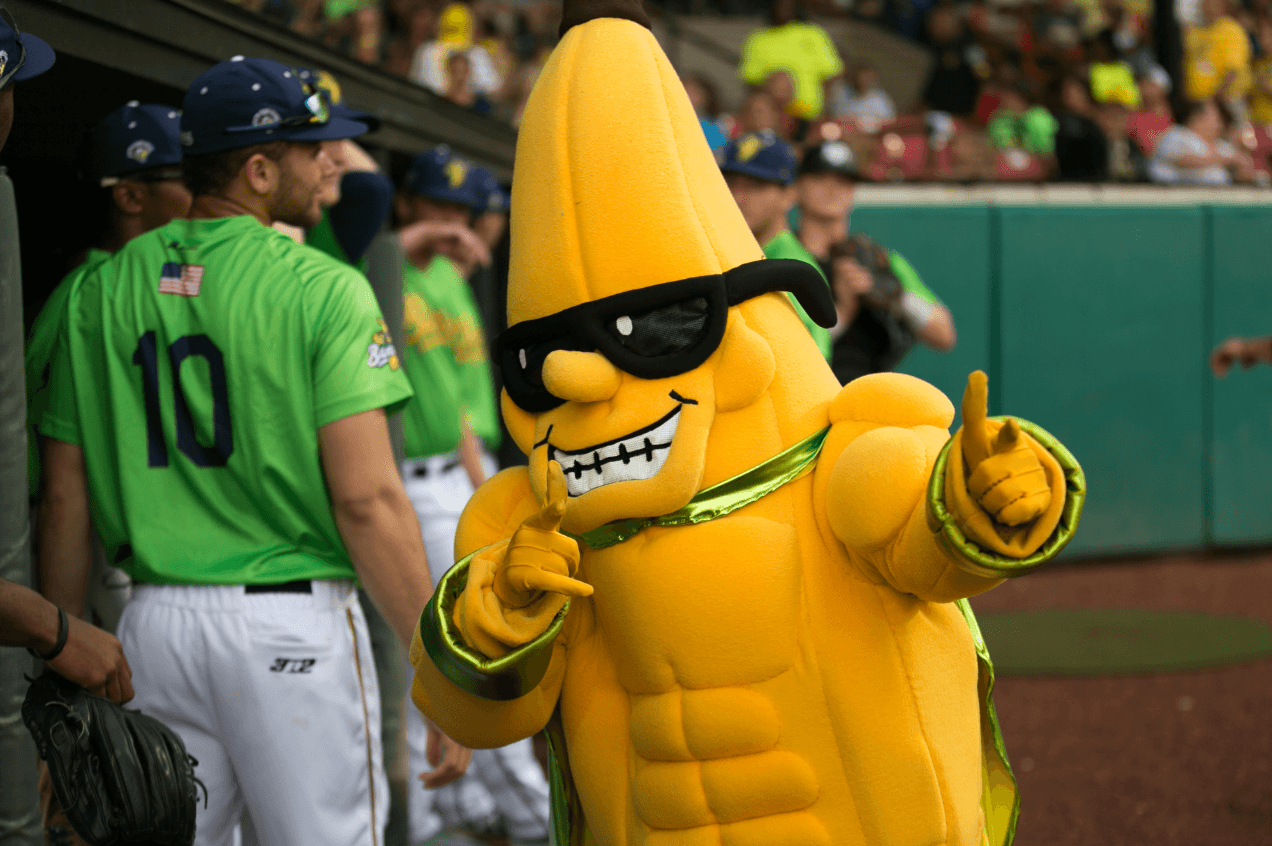No More Ads?
Why the Savannah Bananas Stopped Selling Sponsorship, and What It Can Teach Us About the Future of Sponsorship

Savannah Bananas mascot, Split.
Here’s a sports business headline that will make you do a double-take: “Savannah Bananas Drop Sponsorships and Put Faith in Fan Experience.”
That’s right, the collegiate summer baseball team in the Coastal Plain League has dropped all of its sponsors, and removed all of the ads from the outfield wall at its stadium. They are letting 10-20% of their annual revenue walk right out of the ballpark. In the process, Grayson Stadium—the historic ballpark in Savannah, Georgia and home of the Savannah Bananas—has become the first known stadium in the world to become Ad-Free.
Now, you may be thinking to yourself one of two things:
Who knew there was a pro (or semi-pro) sports team named the Savannah Bananas?
What the hell is the leadership of this team thinking?
Yes, the Savannah Bananas are real, and their logo and jerseys are spectacular. They describe themselves as a circus where a baseball game broke out. And as for what their leadership team is thinking—they believe this is exactly what their fans want.
“This is all in the effort to create the most Fans First experience in sports,” said Bananas Owner Jesse Cole in a statement on the team’s website about the move. “We are relentlessly focused on a better fan experience and we don’t believe anyone comes to the ballpark wanting to be advertised to.”
“For as long as I’ve been in the industry, we’ve sold advertising and sponsorships for our teams and our ballparks. It was just what you were supposed to do. The focus was always to sell the big signs on the outfield wall or sponsor a night at the park,” said Cole. “What we see from consumer behavior trends is that if given the choice, people fundamentally choose to avoid advertising. So, we believe that Bananas fans deserve an ad-free experience.”
“Our focus will always be on serving our fans in a better way not capitalizing on the people we serve.”
Jesse Cole has a point. Pay a visit to minor league baseball stadiums across the U.S., and they look often like this:

An absolute eyesore, right?
In contrast, here’s what the Bananas’ outfield wall looks like, sans advertisements:

The right field “Fan Wall” will be opened up for every single fan who attends a Bananas game to sign their name on the wall. Plus, on the left field wall, they plan to pay tribute to the teams that have played at Grayson Stadium since 1926, by building a historical timeline tracing the ballpark’s history back to the Savannah Indians.
It’s unorthodox. It’s different. It’s innovative. It probably wouldn’t work in the big leagues, right? I’m not so sure about that.
You might say, “John, you’re a sponsorship guy! Why are you spending time writing about a small-town summer league baseball team that stopped selling sponsorship?!”
You’re right. I am a sponsorship guy. But I am a sponsorship guy who is trying to think differently. I’m trying to re-imagine what sponsorship might look like in the future. Are we sure that ads plastered on outfield walls or on scoreboards and digital banners are moving the needle?
How might sponsorship be better? How might it serve consumers better, and get better results for companies? Why has it been done a certain way for so long? Why haven’t we seen much innovation in sponsorship?
Reading about the Savannah Bananas, and watching this incredible video on their origin story, I was really struck by this single lesson for their success: they put the fans first. Their mission is: Fans First. Entertain Always.
All the team has done since establishing that mission is record 88 straight sell-outs of their games and “lead the Coastal Plains League in attendance with 117,729 fans—more than twice as many as the second-place Macon Bacons,” according to Front Office Sports. They have become a pillar of the community in Savannah, Georgia.
If sponsorship is all about helping brands become the number one choice among a very specific target market, how might brands think like the Savannah Bananas, and put the consumer first?
I love what the Jesse Cole, and Bananas President Jared Orton are doing here. And by the way, I don’t believe they are 100% done with sponsorship. Given the incredible brand, fun social media accounts, and content creation machine that they have created in Savannah, they may very well be able to re-imagine what sponsorship and/or partnership will look like for the team. Something tells me they just won’t call it “sponsorship.” It will probably be called “fan service partners.”
The future of sponsorship does not lie in plastering logos all over stadiums and arenas. It lies in entertaining, delighting, serving, and inspiring consumers. It lies in in-person and digital experiences and touch points that create human connection and positive emotion.
As marketer and author, Mark Schaeffer wrote in his book, Marketing Rebellion, “the most human company wins.”
The Savannah Bananas are a smash hit (no pun intended) because they are a brand and a company that’s obsessed with human connection. They are obsessed with serving and delighting their fans. Even though they aren’t selling sponsorships anymore, we could all learn something from them in the sponsorship deals and activations that we build going forward.
Win-Win-Win is a newsletter and community for purpose-driven leaders in the sports and entertainment industry. Once a week, on Thursdays, I’ll send you a thoughtful essay/blog post about how we might leverage the influence of our industry for good. Please reach out to me on Twitter or LinkedIn if you’d like to connect and discuss my work or find ways that we might collaborate.



